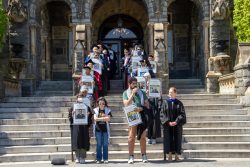On Wednesday, Georgetown’s University Information Services removed the WiFi network HOYAS due to its lack of security. According to an email from UIS, the removal is part of the University’s “Fast Deployment Wireless” project focused on replacing first-generation wireless routers. SaxaNet and GuestNet have now completely replaced HOYAS, providing students with safer WiFi networks, Chief Information Officer Lisa Davis said.
“HOYAS was an unsecured wireless network that the whole school used to use,” said Tech Center Special Projects Coordinator Kevin Perlow (MSB ’13). “Basically, the biggest issue was that you could intercept wireless traffic using Firesheep or Wireshark, and that just isn’t good.”
According to Perlow, these two “packet sniffing” programs can detect and intercept wireless traffic on these open networks, allowing for information to be stolen. Using sites that begin with “https” could prevent this, but some sites do not encrypt, or conceal, passwords. Davis explained that the school began its removal of HOYAS about two years ago because of these risks.
Although GuestNet is open and unsecured as HOYAS was, it prevents information theft and virus attacks by blocking almost all ports, which are communication endpoints. Port 80 is the exception, allowing for web traffic but blocking other functions, such as the downloading and sending of emails.
SaxaNet, on the other hand, is a WPA2 Enterprise encrypted network, meaning everyone using the network has a unique ID and password. A virus would not have the login information necessary to access the network.
Adoption of WPA2 Enterprise comes with some costs. As a Microsoft product, it is not as compatible with Mac software. Perlow said the Tech Center has noticed the WiFi works well on Windows but “cuts in and out” on Mac computers, denying users a consistent connection.
“The Internet connection has been very problematic,” said Macbook user Irem Cesur (MSB ’15). “It’s been worse than ever, and it affects our studying.”
Perlow says the struggles come with the territory. “Other schools use the same software,” he said. “I was over at [the University of] Chicago a year ago, and they were using it, too … So if people are frustrated by it, they should just keep in mind that this is kind of the best that there really is for this.”
UIS has been working to improve Internet access.
“The Fast Deployment Wireless project replaced 311 first-generation wireless radios located in 19 buildings this summer,” Davis said. “The project improved wireless security and performance but did not address the need for complete wireless coverage in all campus buildings.”
This project is a part of the University’s Wireless Everywhere project, which will begin by adding 81 new routers in New South and 214 in Southwest Quad.
“Funding has been approved and UIS is working with [University Facilities and Student Housing] and the contractors to schedule the work in student rooms,” Davis said. UIS expects this part of the project to be completed during the spring 2013 semester. Their goal is to eventually cover the entire campus, including outdoor areas—a big change from just a few years ago when ethernet cables were required in many areas.
“I didn’t really have WiFi in any of my dorms until junior year,” said Bill McGoey (MSB ’13). “I think it’s kind of ridiculous that Georgetown waited so long to implement WiFi.”




